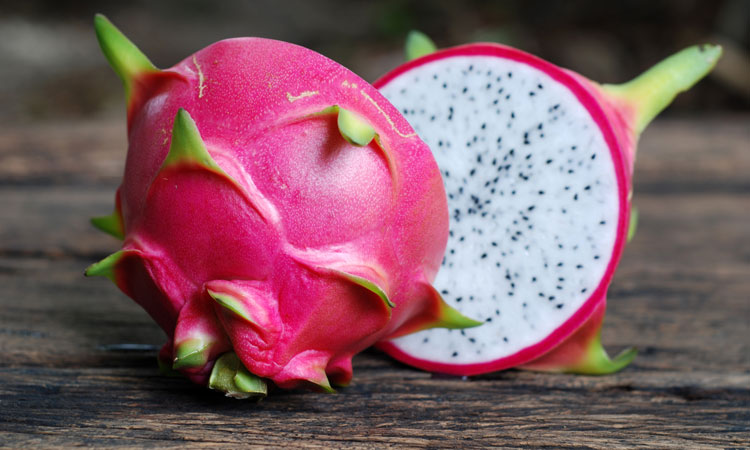Dragon fruit – a majestic appearance and health benefits to match
- Like
- Digg
- Del
- Tumblr
- VKontakte
- Buffer
- Love This
- Odnoklassniki
- Meneame
- Blogger
- Amazon
- Yahoo Mail
- Gmail
- AOL
- Newsvine
- HackerNews
- Evernote
- MySpace
- Mail.ru
- Viadeo
- Line
- Comments
- Yummly
- SMS
- Viber
- Telegram
- Subscribe
- Skype
- Facebook Messenger
- Kakao
- LiveJournal
- Yammer
- Edgar
- Fintel
- Mix
- Instapaper
- Copy Link
Posted: 26 May 2021 | Tania Dey PhD | No comments yet
Introducing the eye catching dragon fruit – a delight to our senses and health alike, as Tania Dey explains.


An exotic looking fruit has recently entered the tropical fruit market. Attracting consumers with its bright magenta coloured spikes and an equally appealing white dotted interior, this majestic fruit is called Dragon Fruit or Pitaya or Strawberry Pear (Hylocereus undatus). The flowers of this cactus plant, also known as the Honolulu queen, open at night only. The most popular variety has a white pulp studded with tiny little black seeds, although the less common types include red pulp with red skin and white pulp with yellow skin. It is mildly sweet and tastes somewhat like a pear and kiwi with a crunchy texture. This fruit makes an ideal ingredient for smoothies and fruit salads.
Origin of dragon fruit
Dragon fruit is indigenous to Mexico and Central America but was introduced to Southeast Asia, first in Vietnam, by the French in the late 19th century. Today, Thailand, Taiwan, Myanmar and Sri Lanka have an emerging dragon fruit production and distribution market. The name ‘dragon fruit’ is derived from its unique appearance, where the spikes resemble fire and the scales resemble that of a dragon, as depicted in Chinese mythology.
Health benefits
Dragon fruit can be considered as a superfood, being low in calories but high in fibre, antioxidants, phytonutrients, vitamins and minerals, and containing healthy fatty acids and probiotics. Antioxidants are essential to protect cells from free radical damage, which cause chronic disease and ageing. Some of the major antioxidants found in dragon fruit are betacyanins, betaxanthins, hydroxycinnamates and flavonoids. According to a research article published in the World Journal of Pharmacy and Pharmaceutical Sciences in 2018,1 the antioxidant activity of the fruit can be helpful in preventing inflammatory conditions such as gouty arthritis. Hydroxycinnamates have proven anticancer activity, while flavonoids are linked to better brain health and reduced risk of heart disease.
A phytochemical named captin, which is often used in heart medication, is present in dragon fruit as well. Lycopene, responsible for the fruit’s red colour, is known to lower the risk of developing prostate cancer.
Dragon fruit contains a significant amount of carotene, which can improve eyesight, vitamin C to boost the immune system (10 percent of the daily recommended value), B vitamins to aid carbohydrate metabolism, calcium to develop strong bones and teeth, iron for forming healthy red blood cells, and phosphorus to promote tissue and cell growth.
Animal studies show some positive effect of dragon fruit on type 2 diabetes, although the results are not always conclusive. Research studies also show that dragon fruit may improve insulin resistance and reduce liver fat. However, feeding lab rats with dragon fruit juice caused better blood sugar response and reduction in some liver enzyme markers, while other liver enzyme markers significantly increased.
The tiny seeds present in the fruit are an excellent source of omega-3 and omega-9 fatty acids, which are known to lower the risk of cardiovascular disorders. The natural oils extracted from the seeds can serve as a mild laxative as well.
According to a study in the Electronic Journal of Biotechnology in 2014,2 dragon fruit nourishes gut bacteria which can have a probiotic effect on the body. A specific type of carbohydrate, called oligosaccharide, present in dragon fruit can also stimulate the growth of healthy bacteria in the stomach and intestines. Probiotics are excellent for improving digestion and immunity and for lowering intestinal infections.
Not a bit is wasted
The skin of dragon fruit is usually discarded due to its bitter flavour, but some people will pickle the skin or incorporate it into a salad. This adds the benefit of additional flavonoids, which are antioxidants with anti-inflammatory properties. A group of Malaysian scientists in 20133 reported the production of a natural healthy food colourant called Dragon Fruit Coloring Powder (DFCP) derived from the waste peel or albedo of the dragon fruit. Other applications of dragon fruit peel are skin-beautifying facial masks, nutritious low-cost tea, and anti-dandruff formulations.
In a nutshell, this emerging fascination with dragon fruit is not only due to its aesthetic appeal, but to its immense health benefits aided by scientific research. However, a few cases of severe allergic reactions have been reported in female consumers.
References
- Mayuri SS, et al. (2018). “Dragon fruit as a nutraceuticals”. World Journal of Pharmacy and Pharmaceutical Sciences. Article ID 8769.
- Dwivedi S, et al. (2014). “Plant prebiotics and human health: Biotechnology to breed prebiotic-rich nutritious food crops”. Electronic Journal of Biotechnology 17(5): 238-245.
- Moshfeghi N, et al. (2013). “Introducing a new natural product from dragon fruit into the market”. International Journal of Research and Reviews in Applied Sciences 15(2): 269-272.
About the author
Tania Dey is a senior scientist, currently working as an independent chemical consultant. She has 18 years post-PhD research experience from North America and Europe. She regularly offers technical advice on food and materials formulations.
Related topics
Related organisations
Electronic Journal of Biotechnology, World Journal of Pharmacy and Pharmaceutical Sciences
Related regions
Asia Pacific & Oceania, Central and South America, Central and South Asia









